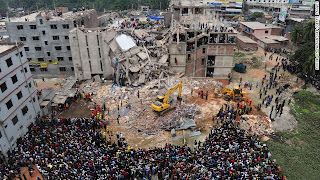Bangladesh’s Garment Industry
Globalization created the opportunity to capitalize on cheap labor in developing countries. Although China remains the primary source of apparel manufacturing for many developed nations, the country’s demand for increasing wages has lead to the search for new labor markets. A new sources of cheap labor is Bangladesh—one of the poorest countries in the world, located in South Asia. Bangladesh has a population of approximately 160 million, and remains plagued by corruption, massive poverty and political instability.
A Deathly Shortcoming:
The cheap labor in Bangladesh has made it the second biggest apparel exporter—an industry worth $19 billion. The wages for the workers in Bangladesh are a meager $0.18-$0.26 an hour, while China’s workers average $1.34 an hour. This motivated many manufacturers, like Wal-Mart and Sears to shift its production to the country, allowing them to squeeze out a slightly higher margin. However, the working conditions for Bangladeshi workers include an added danger—poor infrastructure. The improper designs and structures, an obvious lack of safety measures and faulty electrical wiring in many garment factories has led to the death of a shocking number of people.
Incident #1:
Last November, a fire started in a garment factory with no emergency exits and led to the death of at least 112 workers, who were trapped inside. Many jumped out from the 8-storied building in an attempt to escape the torturous flames. The factory was owned by Tuba Group, which made products for Wal-Mart, Carrefour and IKEA. The fire department operations director of Bangladesh, Mohammad Mahbub, stated “Had there been at least one emergency exit through outside the factory, the casualties would have been much lower."
Incident #2:
On April 24th, a factory complex located in Dhaka, Bangladesh’s capital, collapsed and killed at least 362 people. The search and rescue operation is still in process, as hundreds of workers remain missing. This complex housed five huge garment factories and numerous other manufacturing operations. Although workers reported worrisome cracks in the building, the garment factories threatened to dock their workers’ pay if they did not return to work. The building collapsed soon afterwards, killing hundreds who were forced to work inside. A fire and mass protest broke our in the midst of rescue efforts. Bangladeshis are frustrated by the lack of safety precaution or even effort for improved conditions by the multinational firms that receive the end products.
Taking on Responsibility:
Although the government of Bangladesh hopes to enforce better working standards and demand more responsibility from national apparel companies, they fear that in response, the major players will take their business elsewhere—countries like Cambodia and Vietnam prove to be a viable alternative. According to the manufacturers association, textiles contribute about 80 percent of the Bangladesh’s exports. A huge chunk of Bangladesh's population remains dependent on the scanty wages from the garment factories and will have no choice but to return to work, as soon as the outrage dies down. With the government stuck in a delicate situation and with minimal incentive for multinational apparel companies—will Bangladeshi workers ever see better conditions?
Ritika Gawande
Photo Credit: www.cnn.com
Photo Credit: www.cnn.com
Sources
"FIRE KILLS 112 WORKERS AT BANGLADESH GARMENT-MAKER." The BigStory. N.p., n.d. Web. 28 Apr. 2013.
"Garment Units Shifting Bases to B'desh." The Times Of India. N.p., n.d. Web. 28 Apr. 2013.
Horowitz, Alana. "Bangladesh Building Collapse: Fire Breaks Out In Factory Wreckage." The Huffington Post. TheHuffingtonPost.com, 28 Apr. 2013. Web. 28 Apr. 2013.
"Will Wal-Mart Move Manufacturing Out of Bangladesh?" Bloomberg Businessweek. Businessweek, n.d. Web. 28 Apr. 2013.


Comments
Post a Comment